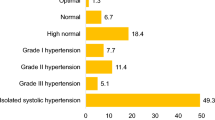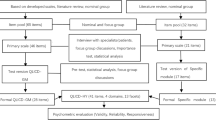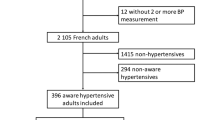Abstract
The objectives were to study the associations of perceived health care-related and patient-related factors with self-reported noncompliance with antihypertensive treatment. General practitioners identified all of their hypertensive patients in 26 health centres during 1 week in 1996 (n = 2219). A total of 1782 (80%) patients participated in the study, of whom 1561 were on antihypertensive medication. Based on 82 opinion statements in two questionnaires, 14 problem indices were formed by using factor analysis. Out of these, summary variables concerning problems related to the health care system and the patients were formed. Logistic regression models, including interaction analyses, were used to study the associations with non-compliance. The results were that the majority of patients had at least one perceived health care system-related (88%) and patient-related problem (92%). A high number of both perceived health care system-related problems (adjusted OR 4.77; 95% CI 2.76, 8.26) and patient-related problems (adjusted OR 3.23; 95% CI 1.79, 5.81) were associated with self-reported non-compliance. The experience of adverse drug effects was also associated with non-compliance (adjusted OR 1.41; 95% CI 1.03, 1.94). In conclusion self-reported non-compliance was associated with multiple risks of both perceived health care system-related and patient-related problems.
This is a preview of subscription content, access via your institution
Access options
Subscribe to this journal
Receive 12 digital issues and online access to articles
$119.00 per year
only $9.92 per issue
Buy this article
- Purchase on Springer Link
- Instant access to full article PDF
Prices may be subject to local taxes which are calculated during checkout
Similar content being viewed by others
References
Hyman DJ, Pavlik VN . Characteristics ofpatients with uncontrolled hypertension in the United States N Engl J Med 2001; 345: 479–486
Takala J, Kumpusalo E, työryhmä . Verenpainepotilas terveyskeskuksessa: hoidossa yhä parantamisen varaa Suom Lääkäril 2001; 56: 269–274
Kumpusalo E, Pärnänen H, Takala J . Treatment situation of hypertensivepatients in Finnish primary health care Blood Press 1997; 6 (Suppl 1): 35–39
Suomen Verenpaineyhdistys ry:n asettama työryhmä. Käypä hoito – suositus. Kohonneen verenpaineen hoito Duodecim 2002; 118: 110–126
Ramsay LE et al. Guidelines for management of hypertension: report of the third working party of the British Hypertension Society J Hum Hypertens 1999; 13: 569–592
1999 World Health Organization. International Society of Hypertension Guidelines for the Management of Hypertension J Hypertens 1999; 17: 151–183
Setaro JF, Black HR . Refractory hypertension N Engl J Med 1992; 327: 543–547
Enlund H, Jokisalo E, Wallenius S, Korhonen M . Patient-perceived problems, compliance, and the outcome of hypertension treatment Pharm World Sci 2001; 23: 60–64
Jokisalo E, Kumpusalo E, Enlund H, Takala J . Patients’ perceived problems with hypertension and attitudes towards medical treatment J Hum Hypertens 2001; 15: 755–761
Hosmer DW, Lemeshow S . Applied Logistic Regression John Wiley & Sons, Inc: New York 1989; pp 90–106
Takala J, Niemelä N, Rosti J, Sievers K . Improving compliance with therapeutic regimens in hypertensivepatients in a community health center Circulation 1979; 59: 540–543
Balazovjech I, Hnilica P Jr . Compliance with antihypertensive treatment in consultation rooms for hypertensivepatients J Hum Hypertens 1993; 7: 581–583
Lin C-T et al. Is patients’ perception of time spent with the physician a determinant of ambulatory patient satisfaction? Arch Intern Med 2001; 161: 1437–1442
Bell RA et al. Unsaid but not forgotten. Patients’ unvoiced desires in office visits Arch Intern Med 2001; 161: 1977–1984
Harris LE, Luft FC, Rudy DW, Tierney WM . Correlates of health care satisfaction in inner-citypatients with hypertension and chronic renal insufficiency Soc Sci Med 1995; 41: 1639–1645
Lahdenperä TS, Kyngäs HA . Levels of compliance shown by hypertensivepatients and their attitude toward their illness J Adv Nurs 2001; 34: 189–195
Lee D et al. Relation of hostility to medication adherence, symptom complaints, and blood pressure reduction in a clinical field trial of antihypertensive medication J Psychosom Res 1992; 36: 181–190
Shaw E et al. Factors associated with noncompliance ofpatients taking antihypertensive medications Hosp Pharm 1995; 30: 201–203 206–207
Khalil SA, Elzubier AG . Drug compliance among hypertensivepatients in Tabuk, Saudi Arabia J Hypertens 1997; 15: 561–565
Greenberg RN . Overview ofpatient compliance with medication dosing: a literature review Clin Ther 1984; 6: 592–599
Mallion J-M et al. Compliance, electronic monitoring and antihypertensive drugs J Hypertens 1997; 16 (Suppl 1): S75–S80
Waitzkin H . Doctor-patient communication. Clinical implications of social scientific research JAMA 1984; 252: 2441–2446
Tschann JM, Adamson TE, Coates TJ, Gullion DS . Behaviors of treated hypertensivepatients andpatient demographic characteristics J Community Health 1988; 13: 19–32
McCombs JS, Nichol MB, Newman CM, Sclar DA . The costs of interrupting antihypertensive drug therapy in a Medicaid population Med Care 1994; 32: 214–226
Bloom BS . Continuation of initial antihypertensive medication after 1 year of therapy Clin Ther 1998; 20: 671–681
Morris LS, Schulz RM . Patient compliance – an overview J Clin Pharm Ther 1992; 17: 283–295
Acknowledgements
We thank the Elli Turunen Fund of the Finnish Cultural Foundation for supporting this study.
Author information
Authors and Affiliations
Corresponding author
Rights and permissions
About this article
Cite this article
Jokisalo, E., Kumpusalo, E., Enlund, H. et al. Factors related to non-compliance with antihypertensive drug therapy. J Hum Hypertens 16, 577–583 (2002). https://doi.org/10.1038/sj.jhh.1001448
Received:
Revised:
Accepted:
Published:
Issue Date:
DOI: https://doi.org/10.1038/sj.jhh.1001448
Keywords
This article is cited by
-
Non-adherence to antihypertensive pharmacotherapy in Buea, Cameroon: a cross-sectional community-based study
BMC Cardiovascular Disorders (2018)
-
Perceived medication use challenges and coping strategies among medical outpatients in Nigeria
International Journal of Clinical Pharmacy (2013)
-
Gender-specific, multi-level determinants of outcomes of antihypertensive treatment: a sub-analysis of the Belgian PREVIEW study
Journal of Human Hypertension (2011)
-
Development of new concepts of non-adherence measurements among users of antihypertensives medicines
International Journal of Clinical Pharmacy (2011)



